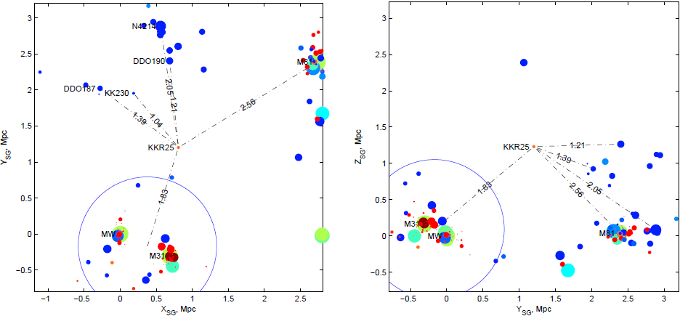

|
A unique isolated dwarf spheroidal galaxy KKR25 |
Russian version |
|
We present a photometric and spectroscopic study of the unique
isolated nearby galaxy KKR25. The isolated dwarf spheroidal (dSph) galaxy
KKR25 was discovered by Karachentseva, Karachentsev & Richter (1999, A&AS,
135, 221) during the search of dwarf galaxies in the direction of the Local
Void. In spite of its isolation KKR 25 has no
gas and looks like a normal dwarf spheroidal system. This fact draws
our attention, because we expect to find dSph galaxies in dense
regions, like groups and clusters of galaxies. Obviously, that any
kind of interaction with massive galaxy is not suitable to explain
properties of KKR 25. This galaxy can play a crucial role in testing
of different scenarios of dSph's formation.

Fig.1.
The map of galaxies in the SuperGalactic coordinates is
centred on KKR 25. The left panel presents the projection of galaxies
on the SuperGalactic plane, while the right panel shows the edge-on
view on the 'pancake' of galaxies. The filled circle size is
proportional to absolute magnitude of galaxies. Galaxies are coded by
a colour from red for early types (T=-5) to blue for late types
(T=10), according to morphological type in de Vaucouleur's numerical
scale (de Vaucouleurs et al. 1991). The zero-velocity surface is shown
by big blue circle around the Local Group. Distance to nearby
structure is marked by dash-dotted lines with corresponding distance
written on it. The brightest galaxies in the volume under
consideration are Milky Way (WM), Andromeda galaxy (M31) and M81. They
are signed on the figures. KK 230 is a closest galaxy to KKR 25. Three
associations of dwarf galaxies (Tully et al. 2006) are shown on left
panel. DDO 190 is the brightest member of 14+08 association. DDO 187
corresponds to 'Dregs' association and NGC 4214 to 14+07. The Local
Void occupies the upper half of the right panel just above KKR 25.
|
Fig.2. HST WFPC2 image of KKR 25 in F814W band. The long slit positions are overplotted. The integrated spectrum of the stellar light was obtained in the slit position '0'. Fig.3. The colour-magnitude diagram based on HST/WFPC2 image of KKR 25. Extremely blue object 4 from our spectroscopic study is shown by open circle. |